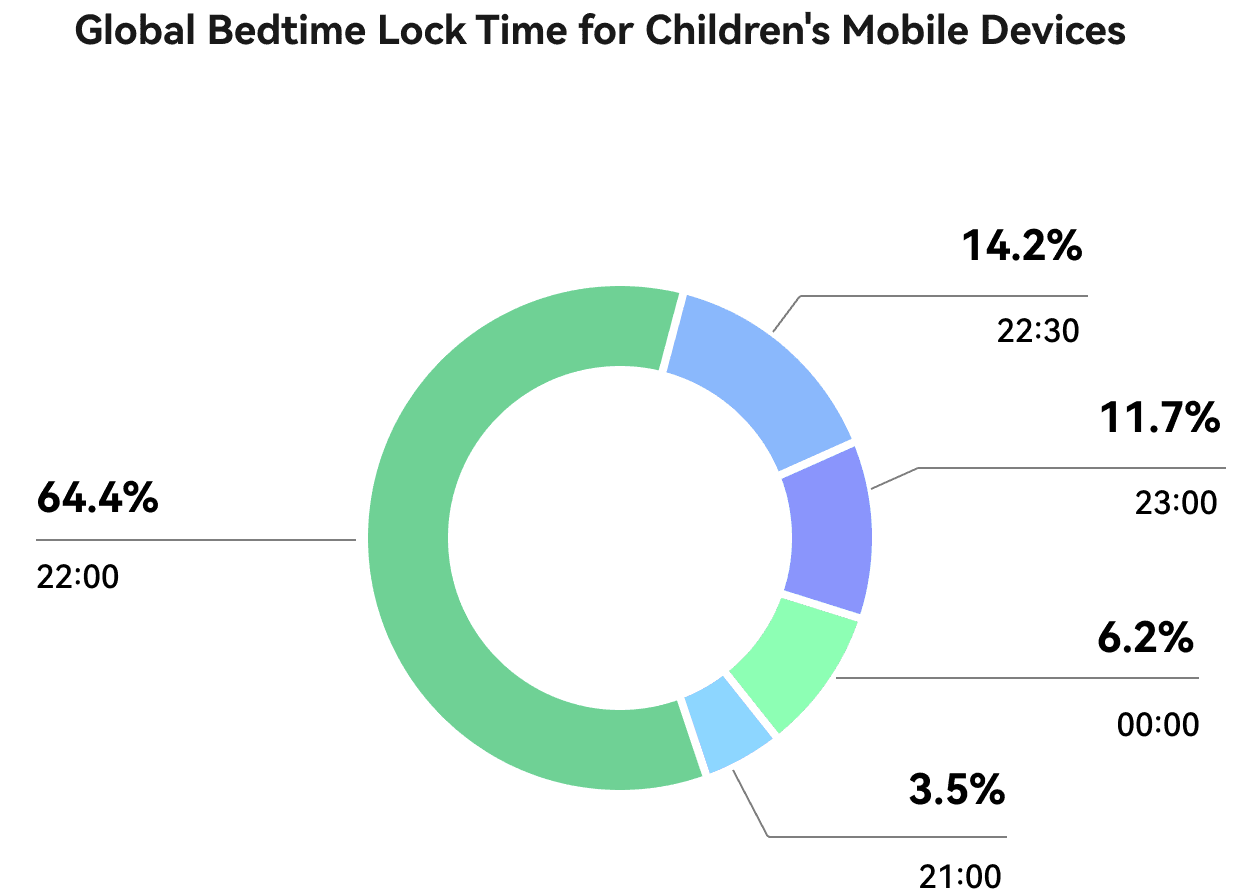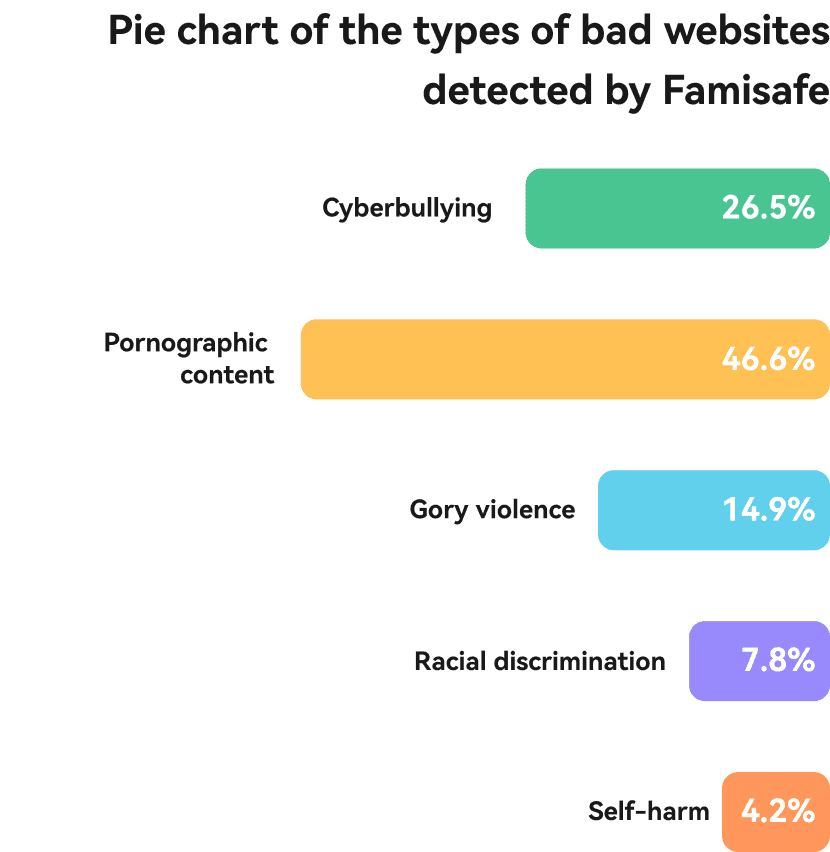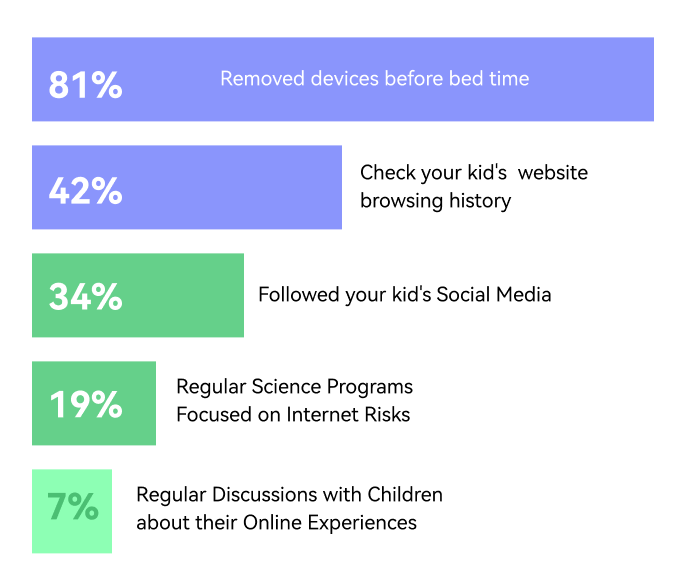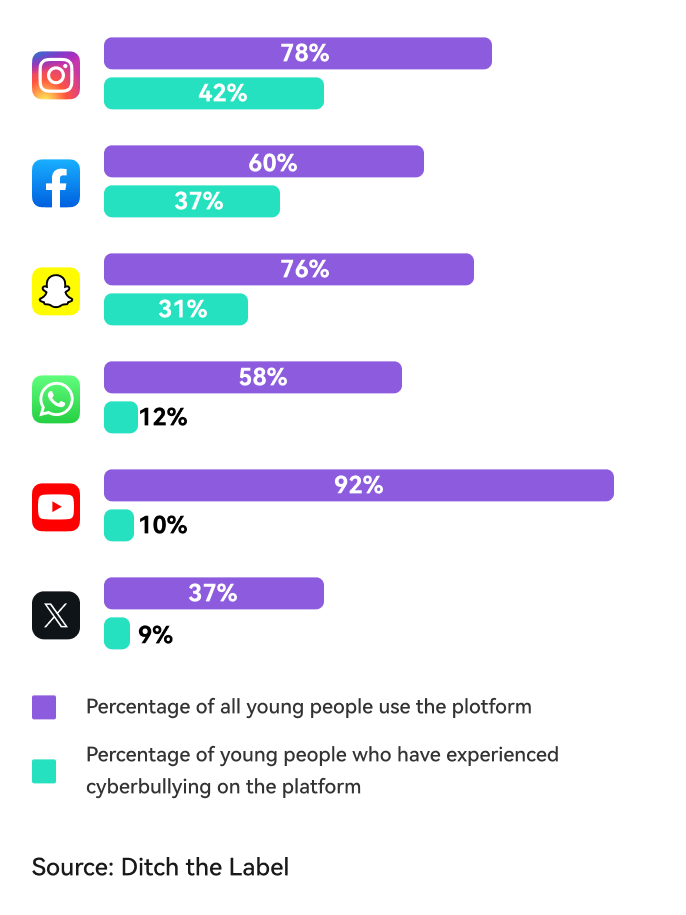In this report
- Generative AI in 2024
- Online and Offline Connection
- The First Smartphone and Tech Free
- Apps Use in 2024
- Parents' Common Concerns
- A Click Away: Access to Obscenity
- Close to Home: The Menace of Cyberbullying
- Unmasking the Shadows: Offline Risk
- Device Management
- AI Monitoring
- Social Media
- Location Tracking
- Offline Protection
- A Reliable SafeKeeper
- Three Major Issues
- Listening to More Voices

Report Highlight


"We have summarized the data of global children's mobile device usage as report highlight ! Looking forward to your thinking and joining. "
—— from FamiSafe team

Device Management
The average daily screen time limit set by parents using FamiSafe for their children's devices was 3.14 hour, significantly lower than the global average of 67% for children's mobile device usage.



Pie chart of the types of bad websites detected
by Famisafe


AI Monitoring
Over the past year, FamiSafe intercepted 158,000+ harmful websites for children and blocked 360,000+ suspicious images while ensuring compliance with privacy policies and legal regulations in various countries.
Location Tracking
Parents have used the child location function 124 million times, and parents and children have completed 687,377 location-sharing sessions. Parents have set up 200,358 geofences, effectively ensuring the safety of their children's offline travel.


Offline Protection
In two months, children worldwide have used SOS Alerts a total of 17,295 times. Approximately 240 children per day encountered an emergency situation.
Annual Total SOS Function Usage in Representative Countries (Unit: Times)

Introduction
This is our first precious meeting with you in the last six years and marks the release of our first report. To achieve this, we have invited over 10,000 FamiSafe users and their children worldwide for in-depth interviews during this summer vacation. This report provides insights into children's current behavior habits and brings together our anxieties, educational thoughts, and valuable suggestions. Finally, we have obtained a helpful guide on how families can use technology to support education in this digital age. Actively using monitoring tools is an efficient way to protect children from potential dangers in the digital world. However, parental care and companionship are the most effective ways to safeguard children's healthy growth.
The report is divided into four parts: the first chapter is an introduction to the current digital world and the background of this report. The second chapter summarizes common concerns among parents, including contentious battles over screen time, sexually explicit content, and cyberbullying; the third chapter is an actual usage data report for parents and children, reflecting the wisdom of parents worldwide; and the four chapter is a conclusion, providing our outlook on the future of digital education.

the User Profile of FamiSafe's Parental Control App by 2024.


From Birth to Integration
Generative AI in 2024
The digital world is constantly evolving and is nothing short of exhilarating. With the ever-growing popularity and advancements in artificial intelligence technology, the era of interconnectivity has finally arrived.
In the first half of 2024, artificial intelligence experienced explosive growth in technology, with generative AI technology remaining highly sought after, providing various services to online users. In 2023 alone, the top 50 AI tools globally generated over 24 billion visits, with an average of 2 billion monthly visits. ChatGPT had the highest usage and popularity, contributing 14.6 billion trips, accounting for over 60% of the total. (Source: Writerbuddy) It is ubiquitous in enterprises, education, and personal learning and life. At the same time, more and more AI virtual technology, AI creation, AI image beautification tools, and text-to-image technology are gaining attention. The growth of AI tools is expected to increase by nearly 40% annually from 2023 to 2030. It can be said that those who do not use AI technology will be eliminated by the times.
Chatgpt's Traffic Share by Top Five Countries (Source:SimilarWeb)


The Top 5 Most Popular AI Software Globally in the First Half of 2024







Global Children's Mobile App Usage
Type Distribution Chart.

Online and Offline Connection
Today, online and offline connections are inseparable as a gateway to opportunities and an unseen abyss. The millennial generation's children are born into the era of the internet explosion, being the "natives" of the mobile internet age. Tablet computers are also commonly found in households, with at least one dedicated for children's use in 75% of European and American families. Stanford Medicine's research reveals that 25% of children own their first smartphone by the average age of 10.7. Consequently, the average screen time for smart devices among global children reaches 4-5 hour per day, a staggering figure. Children's internet use frequency is nearly as high as that of adults, and it is hard to fathom the amount of information they are exposed to daily.
The First Smartphone and Tech Free
— A 45-year-old parent
At what age do you think a child can get their first smartphone?

— A 45-year-old parent


In our survey, 30.2% parents believe that a child could get a smartphone from the age of 12, and only 9.2% believe that they can get a phone after the age of 18. Giving children their own personal devices is in line with the trend of the times. Before giving children their own smartphone, it is important to discuss the following questions with them:







To help Keep your kids online safe, have you ever done the following for them ?

Apps Use in 2024
This annual report summarizes the mobile software usage data among children worldwide during July,2023-July,2024, including the types of software on personal devices and the top five most popular software.( Source : "Teens, Social Media and Technology 2023 " , FamiSafe)




The Digital Dilemma and Freedom
Parents' Common Concerns
Behind parents' vital control needs, there is anxiety about children developing bad habits, helplessness towards the complex online environment, and concerns about offline safety risks for their children.
"As an adult, I know how harmful smartphones can be, and I dare say that adults are easily addicted to them, let alone children."
- A 45-year-old parent, France
" I fight with my parents every day! Because they won't let me play on my phone. It's not fair! They get to use their phones every day, so why can't I? "
- A 13-year-old teenager,America


" I fight with my parents every day! Because they won't let me play on my phone. It's not fair! They get to use their phones every day, so why can't I? "
- A 13-year-old teenager,America
Among the dangers posed by online networks, early exposure to pornography is the primary concern for parents, followed by the adverse effects of excessive internet use, such as cyberbullying, internet addiction, vision deterioration, and poor sleep. According to surveys, 51% of American teenagers claim to have a high likelihood of encountering pornography while online. In the UK, approximately 21.5% of 10-year-old children are addicted to social media for at least 1.5 hour every night, equivalent to one sleepless night per week. Research from the American Journal of Psychiatry indicates that teenagers who spend more than 3 hour browsing social media platforms daily are more prone to mental health issues such as depression, anxiety, aggression, and antisocial behavior.
At what age do you think parents should start using children's device control products?


Most participants believe that parents should start using children's device control products when their children are between the ages of 7-9, with a percentage of 24.37%. The next highest age group is 10-12 years old, with a rate of 21.58%.

A Click Away: Access to Obscenity
Just a simple click on a link can stumble upon inappropriate pornography. In this highly digitalized era, accessing pornography has become easy to hide. A decade ago, we could only sneak a peek at pornographic magazines hidden under the bed or secretly play DVDs when our parents were not at home. Nowadays, children only need to swipe their phone screens to access inappropriate content easily.
According to a survey in the UK, 1 in 4 teenagers aged 16-21 have been exposed to pornography since primary school, and by the age of 13, 60% of children have encountered pornographic content. Among
them, 38% of children said they accidentally stumbled upon pornographic content. For example, Joanne Schneider's son accidentally entered a pornographic website when he was eight years old after searching for a dirty word he heard at school on a search engine. Meanwhile, a survey of over 1,300 American teenagers aged 13 to 17 showed that the average age of exposure to online pornography in the US is 12 years old. Even when parents see these alarming statistics, many still stubbornly believe it has nothing to do with their children.
At What Age do Children Begin to Be Exposed to Pornography?



Close to Home: The Menace of Cyberbullying
The digital world is like a rabbit hole, which may lead to either light or darkness. A child's innocent online browsing may expose them to cyberbullying, privacy breaches, fake news, online crimes, and more. To address this issue, in the first half of 2024, we launched an online campaign called "Say No to Cyberbullying" at the FamiSafe Website. According to a survey from the Internet, at least 59% of children worldwide have experienced cyberbullying, but only 10% of them seek help from their parents.
Survey of “ Have you ever experienced cyberbullying?”

Survey of “Have you ever experienced
cyberbullying? ”


As a result, major websites and social media platforms have provided ways to protect children and adults from cyberbullying. However, when we delve into the question of whether social networks have taken sufficient measures to prevent cyberbullying, 71% of people believe that current efforts are still inadequate. Social media has become a breeding ground for cyberbullying, with the potential to target anyone at any time.
Unmasking the Shadows: Offline Risk
Even though we hope to provide children with a safe environment through our best efforts, we must also face the potential dangers in life, such as getting lost, contacting bad people, human trafficking, sexual predators, school bullying, traffic accidents, and so on. Children and teenagers spend two-thirds of their day in school, a breeding ground for many adverse events. According to data surveys, when children are bullied, 30% of victims say they have not told anyone about their experience, and the reason they choose to hide it from their parents is mainly due to fear of retaliation. Children who are victims of cyberbullying express concern that they may lose the opportunity to use their phones and computers.
Who do children tell when they are bullied?

Annual Real User Report
This report studied the actual mobile phone usage habits of children and their parents from July 2023 to July 2024. We have summarized the data and conclusions in five dimensions: device management, AI monitoring, social media, location tracking, and offline protection.
Device Management
Over the past year, the average daily screen time limit set by parents using FamiSafe for their children's devices was 3.14 hour, significantly lower than the global average of 67% for children's mobile device usage(4.3 hour). The United States kids in FamiSafe had the highest screen time of all countries with 3.85 hour.
Approximately 64.4% of parents set the bedtime lock time for their children's devices at 22:00. Among various softwares, parents blocked online video apps such as YouTube for the most extended duration.
Global Bedtime Lock Time for Children's Mobile Devices

Average Weekly Screen Time Changes Set by Parents for Children(Hour)


AI Monitoring
Over the past year, FamiSafe intercepted 158,000+ harmful websites for children and blocked 364,000+ suspicious images while ensuring compliance with privacy policies and legal regulations in various countries. It is evident that the greatest risk to children is exposure to explicit content, accounting for 46.6%.
"One time, I accidentally clicked on a pop-up window on a webpage, and it suddenly redirected me to an extremely violent website. I was really taken aback by it."
- a Teenager, 16
The Screen Viewer , which allows parents to capture screenshots of their children's devices remotely, is a powerful monitoring tool to address extreme behavior in children, such as preventing suicide, depression, drug use, and other issues. According to data, parents in the United States use this feature the most frequently, with an average of 44,613 remote screenshots taken per day, followed by India and South Korea. This indicates that parents place great importance on protecting the online safety of their children. However, it is essential to note that this feature should be used in appropriate circumstances and with open communication with the children to strike a balance between monitoring and privacy rights.
Pie chart of the types of bad websites detected by FamiSafe

Average daily usage of the Screen Viewer for representative countries

Location Tracking
As children grow up, their curiosity and desire to explore the world will strengthen.We suggest parents train children as early as possible how to distinguish traffic rules and use transportation tools and give children more independent space under the condition of ensuring safety.
Since the launch of the location-sharing feature, it has been widely loved by parents and children. Parents have used the child location function 124 million times, and parents and children have completed around 687,377 location-sharing sessions. Parents have set up 200,358 geofences, effectively ensuring the safety of their children's offline travel.
Top Five Countries with the Most Use of Location Sharing (Unit:Times)

"As children grow older, they sometimes don't always tell the truth to us. Last time, I received an alert and realized that my child had gone to the riverside. It scared me, but luckily, I had set up a geofence in FamiSafe. Otherwise, I wouldn't have known that they went to the riverside to play."
- A Mother from Brazil


"My mom told me that she can always know my location, and I can also send out a distress signal, so I feel less scared now."
8-year-old child from Germany
Offline Protection
To better safeguard the offline safety of children, we launched the SOS alerts at the end of May. As of the end of July, within 72 days, children worldwide have used this feature a total of 17,295 times. This means that approximately 240 children per day have initiated emergency calls to their parents in real life. Among them, children from India and Brazil have the highest frequency of using this feature.Children's offline travel safety can not be ignored.
We suggest that parents cultivate kids' safety awareness as soon as possible, understand risk factors in the surrounding environment, and clearly know how to call for help as soon as possible.
"One time, my phone was on silent, and my partner and child couldn't reach me. They were very worried, so my child activated the SOS function. Thanks to FamiSafe, the alert went off immediately."
- a Mother from America



Annual Total SOS Function Usage in Representative Countries (Unit: Times)

Total Environmental Sound Monitoring Function Usage in in Representative Countries within two Months (Unit :Times)

Conclusion
A Reliable SafeKeeper
In 2024, FamiSafe began to donate to UNICEF to contribute its effort. With more parents joining the FamiSafe family, over 790,000 global users were added in the first half of 2024. On average, FamiSafe's parental app is used 8 times a week averagely, focusing on the weekends. FamiSafe is dedicated to helping parents alleviate their anxieties about education and lack of companionship, and safeguarding children's online and offline safety remains its essential mission in the past, present, and future.
From a babbling three-year-old to an independent-thinking teenager, children may encounter countless challenges and obstacles along the way. How to lend a helping hand at each stage of their growth and effectively assist both children and parents is a matter of genuine concern.
Therefore, focusing on early childhood education for ages 3-8, we concentrate on helping children resist the temptations of the digital world and avoid potential online risks. We have introduced features such as screen time management, app locking, and time scheduling to cultivate healthy device usage habits.
For teenagers aged 9-14, we address the changes during adolescence and the high frequency of social and communication media usage. We have introduced features such as suspicious image detection, supervision and blocking of inappropriate words, filtering of illegal websites, traceable internet usage records, monitoring of social media apps, and supervision of text messages and phone calls to prevent children from encountering cyberbullying and exposure to harmful online content at an early age.
For teenagers aged 15-18, considering their desire for independence and intense curiosity about the outside world, we have introduced features such as real-time location sharing, historical location tracking, geofencing, SOS emergency assistance, one-way environmental audio monitoring, and teenage driving reports. These features give parents complete control over their children's offline safety.
Three Major Issues
This is an irreversible trend of the times resulting from going with the flow. We are pleased and honored that FamiSafe has been involved in this transformation, providing parents with a practical digital tool. How to guide children in the scientific use of smart devices, how to navigate the digital world, and how to accompany them in safe travels are the three most important issues for FamiSafe. We sincerely thank all parents and children worldwide for their trust and support, especially the 10,000 families participating in this in-depth interview. Every piece of data and conclusion in this report not only reflects parental concerns but also embodies parents' educational experiences worldwide.


Listening to More Voices
We are well aware that the risks and challenges of the digital world are constantly increasing. Therefore, we will continue to listen to the voices of parents and children worldwide, continuously improve and upgrade FamiSafe's features, and meet the needs of parents for their children's safety and healthy growth. Our future vision is to become a leading global parental control software, providing parents with comprehensive, professional, and convenient digital solutions and advice.
Finally, we thank you for your support and trust in FamiSafe. We will continue to work hard to ensure children's safety and healthy growth. With our joint efforts, children's future in the digital world will be bright and brilliant!

Disclaimers Copyrights
This annual report is based on user behavior data and aims to provide analysis and summaries of user activities. We comply with relevant laws and regulations and take necessary security measures to protect user privacy and data security. However, we cannot guarantee user data's accuracy, completeness, and timeliness, as it may be influenced by external factors such as network connectivity issues, technical failures, human errors, and more. Therefore, we do not assume any responsibility for decisions or actions made by users based on this annual report.
Furthermore, the analysis and conclusions in this annual report are for reference and information exchange purposes only. They should not be considered a basis for investment, business, or other decisions. Users are responsible for the risks and liabilities associated with using the data in this annual report. We reserve the right to modify, update, or terminate this yearly report at any time without prior notice. We are not liable for any losses or disputes arising from using this annual report.
Please read and understand this disclaimer carefully before using this annual report. Using this annual report, you agree to accept and comply with all the terms and conditions stated in this disclaimer. If you have any questions or need further clarification, please get in touch with us.







Social Media
As of now, the most popular social media among FamiSafe users is TikTok, followed by YouTube. The average daily usage time for YouTube and TikTok is 1.3 hour, accounting for 41.4% of total screen time.Among them, American children use the softwares for the highest time, reaching 1.59. Teen girls spend more time on TikTok than teen boy, while boys spend more time on YouTube.
Daily YouTube and TikTok Screen Time Set by Parents for Children in FamiSafe (Hour)